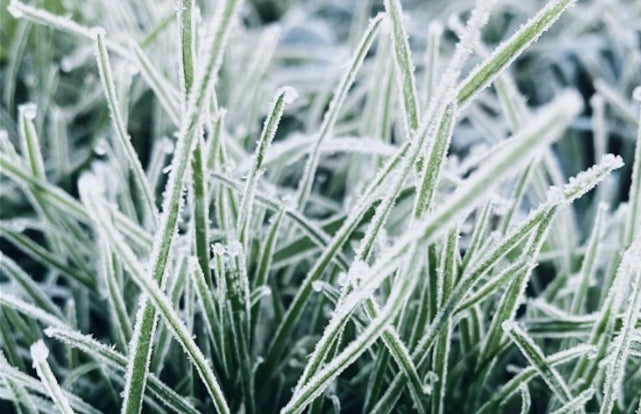Cool, crisp mornings can make your lawn sparkle like glass, but that glittering frost comes with real risk to your grass and garden beds. Those frozen blades and crystal-coated leaves may look serene, yet under that sparkle lies fragile plant tissue that can easily crack under pressure. Understanding why walking on frosty turf harms your lawn, and how to protect your garden when temperatures drop, ensures your landscape stays healthy until spring.

Image 1. Frost on turf.
Why You Shouldn't Walk on Frosty Grass
When frost forms, it turns the moisture within each blade of grass into ice crystals. These frozen cells are rigid and brittle, which means every step can crush or puncture living tissue. After thaw, damaged areas often appear as brown or straw-colored footprints that linger well into spring.

Image 2. Rendition of frost crystals inside and in-between plant cells.

Image 3. Rendition of frost damage in turf from walking traffic.
Frost-damaged turf doesn’t just look rough, it weakens your lawn’s ability to recover from winter stress. Damaged crowns (the growth points of grass plants) are slower to green up and more prone to disease.

Turf tip:
If your lawn is frosty, stay off! Wait until the blades thaw and become flexible again, typically once sunlight warms the surface by mid-morning. Limit foot and pet traffic until then.

Image 4. Frosty landscape.
Frost Protection for Gardens
While turf damage is caused by physical pressure, frost can harm garden plants through freezing and thawing of cells. Fortunately, there are a few simple ways to keep your plants safe.
1. Cover Plants Before Nightfall
Use breathable materials such as frost cloth, burlap, bed sheets, or dedicated garden fleece to trap heat radiating from the soil overnight. Avoid plastic unless it’s propped up so it doesn’t touch leaves directly. Early evening covering is most effective.

Image 5. Row covers.
2. Water the Soil Before a Cold Snap
Moist soil retains heat better than dry soil. A deep watering a day before frost can stabilize soil temperatures and help prevent plant roots from freezing solid.

Image 6. Irrigating the garden prior to an anticipated frost.
3. Add a Layer of Mulch
A light blanket of mulch — such as shredded leaves, pine needles, or straw — insulates roots and helps prevent freeze-thaw cycles from lifting plants out of the ground. Keep mulch a few inches from stems to prevent rot.

Image 7. Mulching.
4. Move Tender Plants Indoors
Container plants, especially tropicals or young seedlings, should be moved into a sheltered space such as a garage, shed, or inside your home when temperatures dip below freezing.
After the Frost
When the frost thaws, avoid raking or pruning immediately as the plant tissues are still delicate. Wait for temperatures to stabilize before gently cleaning up or trimming damaged foliage. If damage does occur, give your turf and garden a slow-release feeding and allow time for natural recovery.
The Bottom Line
Frost is unavoidable, but damage doesn’t have to be inevitable. The simplest prevention method? Stay off the grass until it thaws and cover your garden before temperatures dip overnight. With a few mindful steps and seasonal awareness, your lawn and garden will emerge from winter healthy, hydrated, and ready for spring growth.
Soil health starts from the ground up.
For personalized soil insights and lawn care advice, use a MySoil Test Kit to understand what your soil needs before the next growing season.

Share:
Get Ahead for Spring: The Benefits of Fall Soil pH Amendments